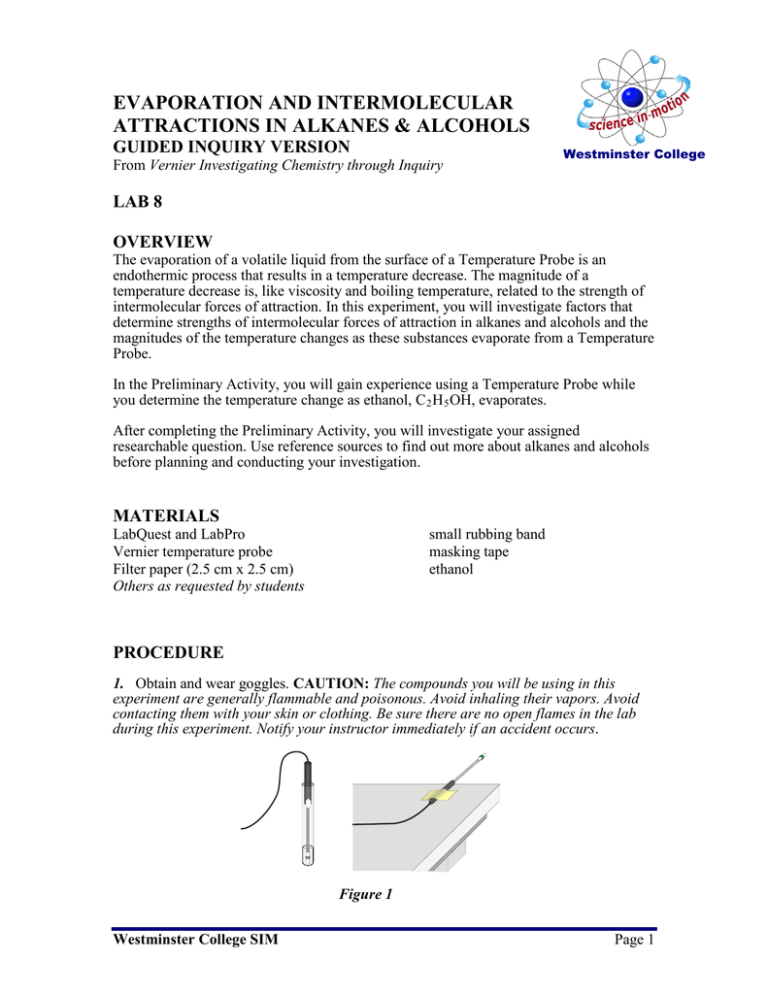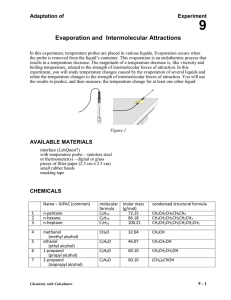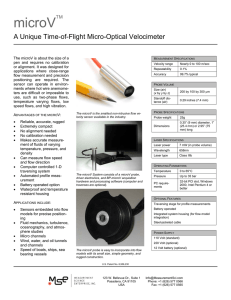EVAPORATION AND INTERMOLECULAR ATTRACTIONS IN ALKANES & ALCOHOLS GUIDED INQUIRY VERSION LAB 8
advertisement

EVAPORATION AND INTERMOLECULAR ATTRACTIONS IN ALKANES & ALCOHOLS GUIDED INQUIRY VERSION From Vernier Investigating Chemistry through Inquiry Westminster College LAB 8 OVERVIEW The evaporation of a volatile liquid from the surface of a Temperature Probe is an endothermic process that results in a temperature decrease. The magnitude of a temperature decrease is, like viscosity and boiling temperature, related to the strength of intermolecular forces of attraction. In this experiment, you will investigate factors that determine strengths of intermolecular forces of attraction in alkanes and alcohols and the magnitudes of the temperature changes as these substances evaporate from a Temperature Probe. In the Preliminary Activity, you will gain experience using a Temperature Probe while you determine the temperature change as ethanol, C 2 H 5 OH, evaporates. After completing the Preliminary Activity, you will investigate your assigned researchable question. Use reference sources to find out more about alkanes and alcohols before planning and conducting your investigation. MATERIALS LabQuest and LabPro Vernier temperature probe Filter paper (2.5 cm x 2.5 cm) Others as requested by students small rubbing band masking tape ethanol PROCEDURE 1. Obtain and wear goggles. CAUTION: The compounds you will be using in this experiment are generally flammable and poisonous. Avoid inhaling their vapors. Avoid contacting them with your skin or clothing. Be sure there are no open flames in the lab during this experiment. Notify your instructor immediately if an accident occurs. Figure 1 Westminster College SIM Page 1 EVAPORATION & INTERMOLECULAR GUIDED INQUIRY 2. Connect the Temperature Probe to the data-collection interface. 3. Set up the data-collection program to collect data for 200 seconds following your instructor’s directions. 4. Wrap the probe with a square piece of filter paper secured by a small rubber band as shown in Figure 1. Roll the filter paper around the probe tip in the shape of a cylinder. Hint: First slip the rubber band up on the probe, wrap the paper around the probe, and then finally slip the rubber band over the wrapped paper. The paper should be even with the probe end. 5. Stand the probe in the ethanol container. Make sure the container does not tip over. 6. Prepare a piece of masking tape about 10 cm long to be used to tape the probe in position during Step 7. 7. After the probe has been in the ethanol for at least 30 seconds, begin data collection. Monitor the temperature for 15 seconds to establish the initial temperature of the ethanol. Then remove the probe from the ethanol and tape it so the probe tip extends 5 cm over the edge of the table top as shown in Figure 1. 8. When the temperature has reached a minimum and has begun to increase, end data collection. If the temperature does not begin to increase, allow data to be collected for the full 200 seconds. Use the Statistics function to determine the minimum and maximum temperature readings. Record these values. 9. Roll the rubber band up the probe shaft and dispose of the filter paper as directed by your instructor. QUESTIONS 1. Subtract the minimum temperature from the maximum temperature to determine ∆t, the temperature change during the evaporation of the ethanol. 2. Draw a structural formula for ethanol, C 2 H 5 OH. 3. Does ethanol have hydrogen bonding? How did you decide? Note: The plan that you submit for instructor approval should list laboratory safety concerns, including chemical safety concerns, and specify how you will address these safety concerns during your investigation. Westminster College SIM Page 2







